Osteochondrosis is a complex of severe degenerative diseases that are located between the vertebrae bones. In this pathological phenomenon, the disc itself is affected, the height changes, and the bone tissue is damaged in the cervical area.Pathology has similar symptoms and certain diseases. The most important thing is to pay attention to the first signal of the body and diagnose it with necessary treatment, otherwise the osteocartilage will begin to progress, causing migraines and blood circulation disorders. Basically, pathology develops among people who reduce motor activity. This is due to the fact that the exchange of mineral salts in the body is disturbed, which causes connective tissue to become thinner and reduce its strength.
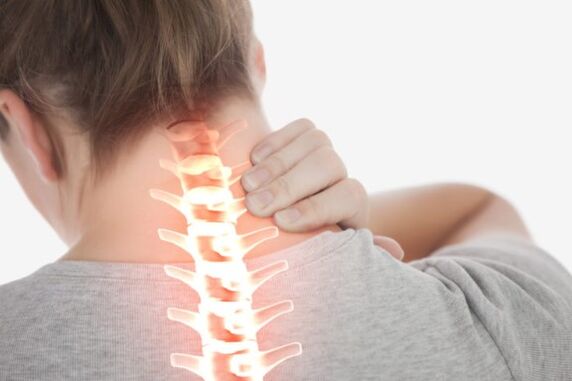
Factors of disease occurrence
The neck is the most moving part of the body, so it experiences a constant load as it must keep the head in place. Certain factors can negatively affect this area of the body and form an inflammatory process in the body's connective tissue.
The reasons for the development of pathological deviation of cervical vertebrae are:
- Not following the rules of power, which is why weight setting;
- Functional changes in the skeletal muscle system;
- hypoemia;
- Neck or spine injury;
- Excessive physical pressure on the spine;
- pressure;
- Physical long-term voltage of the cervical muscle frame;
- Genetics
- Abnormalities in bone development.
All of these factors negatively affect the vertebrae in the cervical area, creating stress, resulting in a smooth and involuntary reduction in skeletal muscle. This leads to the formation of hemofluoroscopy process, slowing of metabolic function, the development of dysfunction and degenerate changes in cartilage. The vertebrae begins to deform, obtains a non-standard shape, and often exceeds the spine.
Symptoms of the disease
Some signs clearly see the initial stages of the pathological process.
- Mind syndrome. It is formed during cerebrovascular spasm, squeezes the brain nerves of cerebrospinal fluid and opposes the background of involuntary intracranial hypertension. It spreads through the occipital bones of the head and neck, affecting the shoulder area and upper limbs. Pain syndrome can be similar to long-term elevation of blood pressure (hypertension), attacks of angina, behaviors that violate cerebral circulation, and manifested in the form of paroxysmal, constant or pulsating properties. Anxiety may increase, mood swings may occur, concentration decreases, and a person becomes irritable and sensitive;
- Dizziness occurs, uneasy movement coordination. Everything is accompanied by tinnitus, nausea, vomiting, and disorientation. It is not always a sign of this pathology, as it can manifest as mean or internal otitis, heart disease, cerebral vasospasm, or impaired neuronal function. Similarly, dizziness usually suffers from vestibular disorder.
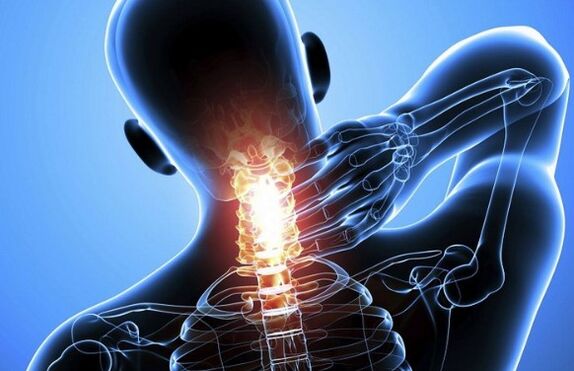
Important!There are two types of dizziness. There is an infeasible dizziness, badness, and it is amazing that it is difficult for a person to be in an upright position. But at the same time, the objects falling into the view will not rotate. With the help of the system, the circular motion of all objects is reflected, indicating violations in the work of vestibular devices, visual perception and muscle spasms. This is a unique sign of dizziness in osteochondrosis.
- Pain on the neck. The pain feels not only in the muscle tissue, but also on the shoulders, including the upper limbs. The pain develops suddenly and lasts for a long time and can be a short time. If the disease does not turn into a recurrence, the pain will pass away after a while, accompanied by a slight specific sound (crunch);
- Arterial hypertension. When the nerve ends, blood pressure rises sharply. Therefore, if increased stress is observed for a long time, this is not a symptom of osteochondrosis. High pressure in this disease combines with brain pain, manual pain, compressing the chest, and the cervical and chest area of the back loses sensitivity. Weakness, fatigue, and lack of strength in the upper limb muscles.
table. Classification of osteochondrosis in the cervical area.
| stage | feature |
|---|---|
| 1 degree | The spinal muscles in the neck are slightly smoother. The pain occurs, which can be exacerbated when moving the head. The tension and weakness of the waist muscles appear. |
| 2 degrees | The size of fibers and ryon formation is reduced, compressing nerve branches. When moving the neck, the pain spreads to the shoulders and the hands will become more intense. Mind syndrome, a feeling of fatigue, distraction, development and expression. |
| 3 degrees | Persistent pain in the upper limbs, cervix and shoulders. Muscle weakness and limb numbness. A hernia formed in the intervertebral disc. The neck is inactive and dizzy. |
| 4 degrees | The fiber and huline formations were destroyed. Connect the fibers to replace damaged cartilage. The destruction process can affect more than one vertebrae segment at the same time. The patient was completely disoriented, with increased pain and dizziness. |
What are the dangers of this disease?
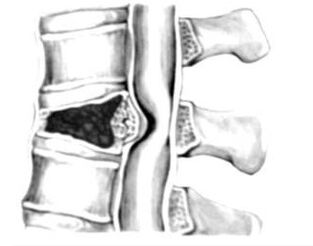
Pathological damage to the entire human body. Through osteocartilage degeneration, tight squeeze of blood vessels, nerve roots, it leads to encephalopathy dysfunction, head syndrome can lead to heart rhythm, vision, respiratory system, concentration, concentration and coordination processes.
The disease tends to cause:
- Various pathology of the brain;
- Many vestibule, vascular, and nutritional diseases;
- Acute violation of the development of ischemia or hemorrhage (spine stroke).
diagnosis
Methods to diagnose disc violations.
- Radiography. Not effective enough in the final stages of the disease.
- Magnetic Resonance Tomography (MRI). A research method that details deviations, pathology of bone structure, pathology of connective tissue, whether there is a hernia, and clarifies its size, location and growth.
- Computed tomography using contrast. Allows you to determine the pathology in the vertebrae. The disadvantage of this study is that it is impossible to determine the presence of spinal cord compression.
- Ultrasound represents. The effectiveness of this method is to determine the reduction of blood circulation through blood vessels.
Characteristics of treatment
In osteocartilage in the treated cervical region, they are based on the degree of disease, their characteristic clinical manifestations and forms. Treatment can be performed:
- Non-surgical treatment, the purpose is to eliminate the symptoms of the disease and manifest themselves in order to alleviate the condition of patients using drugs and physical therapy, to treat exercise, massage;
- Surgical intervention;
- Combination Therapy. In this approach, surgical intervention is performed by further treatment by drug.
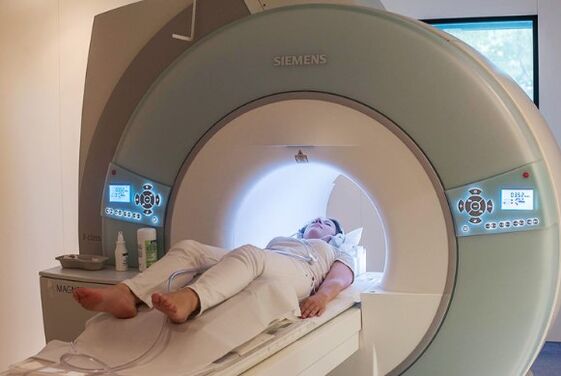
After diagnostic examination, the expert made the final diagnosis and prescribed necessary treatment methods based on the clinical condition of the disease. Basically, if the disease is in a stage where surgical procedures are not required, a complex treatment is prescribed, which includes taking medications, treating performance in exercise, and passing a rehabilitation massage course.
drug
Doctors prescribe medications designed to eliminate pain symptoms, inflammation and muscle tension, restore cartilage tissue, and supplement the body with vitamin mineral complexes in the form of capsules, injections, and plasters.
Therapeutic physical culture (exercise therapy)
Medical sports are specified to restore blood circulation in the cervical area. The movement should not be sharp due to excessive rotation or bent head. It is necessary to imitate the listed actions. Perform exercises for no more than two minutes. The therapeutic complex for exercise involves tilting the head forward and backward without performing an action.
Basic exercises for the treatment of osteochondrosis.
- The "lying" posture of the stomach is accepted. Put your hands on the floor, your head and torso rise. Keep your back straight. It is necessary to be in this position for about 2 minutes in the 2-3 method.
- The "lying" posture of the stomach is accepted. Hands stretched along the body. The head of the head is on the left and right sides, trying to touch the floor with your ears. 6-7 on each side approaches.
- Accept the "sitting" posture. After inhaling, lean forward while trying to reach your head to your chest. When you exhale, you return to its original position, with your head slightly tilting backward. Perform methods 10-15.
- In the "sitting" position, the palms are applied to the forehead while pressure is performed. The head is also extended to the palm, which creates the effect of resistance. Execute the 2-3 method for 2-3 seconds.
- Round head movementExecutions performed on the left and right sides. Perform ten exercises in each direction to avoid dizziness.
Therapeutic massage
In the treatment of osteochondrosis, experts perform massage exercises in the cervical area, clavicle area and upper back. This process must be performed in the position of lies to relax the patient's body.
Main techniques for therapeutic massage:
- Touch- A technique in which huge hand slides along the skin and captures the bottom of the head with less pressure and moves to the upper back.
- extrusion- A technique that has a stronger impact on the skin, subcutaneous tissue and muscle surface layer. The skin of the fingers occurs carefully, bypassing the outer fabric.
- creation- It lies in the transfer and stretching of tissues in all directions to allow the skin and blood to flow to the clavicle area.
- rub- The most difficult technique to affect deep muscle tissue. It is only done with caution at the advice of a doctor, as it can lead to complications of the disease.
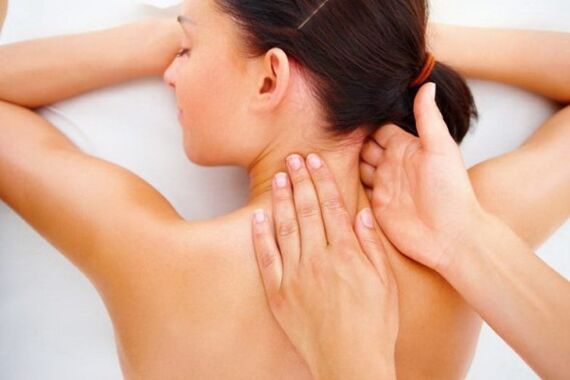
Physical therapy methods
Physical therapy is prescribed for the treatment of pathology of intervertebral discs in the cervical vertebrae.
- Drug electrophoresis- Ultrasound surgery for plant therapy performed under sinusoidal regulation current.
- Laser Therapy- This is a physical therapy that activates blood circulation, eliminating the inflammatory process and reducing pain. Perform laser treatment to improve blood flow.
- Magnetic therapy- One of the methods based on magnetic field exposure, where the effects of tissue edema are eliminated and pain is eliminated.
- Ultrasound therapy- Treatment allows you to relieve pain, inflammation processes while improving blood circulation.
Traditional medicine for treating osteochondral disease in the cervical spine
Folk methods for treating osteochondrosis are not feasible. This is because these methods temporarily relieve symptoms but do not solve the main problem - the initial destructive effect in the spine. At home, plant ingredients can be used as a support complex for primary therapeutic treatment identified by doctors.
For pain in the cervical area, you can use:
- Fly leaves (treated with boiling water, applied to the focus of pain);
- Raw potatoes and honey (scrub potatoes until juice forms, mix equally with honey, and apply to the location where the inflammation is at least once a week);
- Mustard sauce, pepper and alcohol (for local irritation, increase blood circulation and remove pain).

Preventive measures
To prevent the occurrence of a dangerous disease, it is necessary to follow certain rules throughout your life. Following the right way of life can be prevented by many diseases. However, in some cases, the disease is inherited and then it deserves your attention to your health. Dietary nutrition rich in vitamins and minerals and moderate physical exercise will help maintain the body and even prevent the onset of disease.
Doctor's advice will help prevent the disease from occurring:
- Live an active lifestyle and participate in swimming;
- Observe proper nutrition;
- Eat foods with calcium and magnesium (seafood, beans, dairy products, vegetables);
- Do body warmth every day – especially if work is associated with a continuous sitting position;
- Sleep with special orthopedic pillows and mattresses.
In osteochondrosis of any age, it is worth having regular body check-ups and a therapeutic body culture with regular massages, and then using the disease, you can live long and comfortable.


















